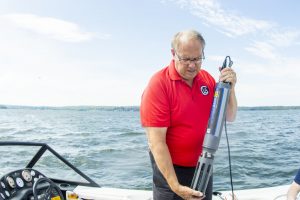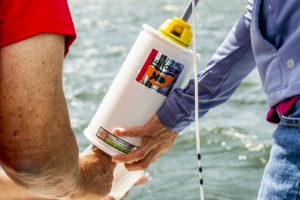
Jane and Doug Conroe sped in their motorboat from their Maple Springs home into the northern basin of Chautauqua Lake, the nose of the boat lifting above the water.
There had been thunderstorms last weekend, but suddenly, at 11 a.m. Sunday, there was an opening to go out to perform tests on the lake. Another storm loomed in the afternoon’s forecast.
They loaded up the boat with testing instruments and zoomed out to a spot off the northwest side of Long Point State Park. They didn’t need a GPS to find the location. They know this spot well, since they have been coming to it every two weeks in the summer, nearly every year for the last 34.
The tests the Conroes perform collect data for the Citizens Statewide Lake Assessment Program, a statewide lake monitoring program run jointly by the New York State Department of Environmental Conservation and the New York State Federation of Lake Associations since 1985. The Conroes’ involvement is a labor of love for the place where they have made their home for the past 40 years.
“She is a living ecosystem,” said Jane Conroe, referring to the lake. “And we, people, have all asked a lot of her. We live here, we love it, we enjoy it. It’s beautiful to look at, it’s fun to play in, it’s great fishing. But, since we all ask so much of her, I feel like I need to help a little bit, do a little bit of anything that I can to help.”
The Conroes have both been dedicated servants to the lake for decades. They have belonged to the Chautauqua Lake Association, where Doug Conroe is now the executive director, since the 1980s. Doug Conroe is the Institution’s former director of operations, and Jane is a retired Maple Grove Junior/Senior High School science teacher. She works with the Chautauqua Watershed Conservancy to educate people about installing rain gardens and shoreline buffer zones to slow and filter water before it enters the lake.
CSLAP exists at Chautauqua Lake thanks to the Conroes, who started volunteering for the program soon after its conception in 1985. In 2019, more than 400 CSLAP volunteers surveyed 176 sites on 157 lakes in the state. They perform biweekly tests that measure water clarity, pH and dissolved oxygen levels. They also collect water samples that they freeze and send to the lab for further testing.

For a lot of the lakes in the program, this is the biggest, longest data set they have, said Nancy Mueller, manager of NYSFOLA. With more than 7,500 lakes in the state, the limited DEC staff could not possibly test each of them, and especially not in the routine way that CSLAP volunteers are able to.
“(The volunteers) are the eyes on the ground. We’re not there,” Mueller said. “They’re the people who live on the lake, they’re the ones who see changes happening. They’re the ones who see invasive species, they report the algal blooms.”
NYSFOLA runs the day-to-day operations of the program, and the DEC is in charge of processing all the data. CSLAP data was used by the DEC to designate Chautauqua Lake as impaired in the early 2000s because its phosphorus levels were, and are, too high.
CSLAP data says phosphorus is increasing, although the rate at which it has been increasing has decreased slightly over the past few years. However, there is no way to know if this trend will continue. It is also very difficult to figure out why the increase in phosphorus has been slowing.
“There’s so many factors,” Jane Conroe said. “In the science world, you do a science experiment and you control all the variables and you change one thing and you see if your thing made the difference. In lab experiments, you’re totally in control. You can put it in a chamber and keep the temperature perfectly stable. Well, out here, Mother Nature just gives it to us.”
Lake associations were first founded to organize social events like picnics and fireworks, Mueller said. Now, they perform important management functions. The CLA runs the mechanical weed harvesting operation on the lake, along with a watercraft steward program that checks boats at public launches for invasive species that might be attached to the boat or trailer. Lake associations use the CSLAP data they collect to inform management decisions.
“From where I sit — and I’ve been here for over 20 years — the level of understanding by most lake associations is so much higher than it used to be,” Mueller said. “It’s so incredible to see the sort of transformation.”
That understanding comes from a routine battery of tests performed every other week in the summer — for a total of eight times. Once the Conroes reached their usual spot on the lake, Jane Conroe used a Secchi disc — a circle cut into quarters that are alternately colored black and white — to test water clarity. She lowered the disc into the water on the shady side of the boat until it disappeared from her vision. Then, she measured the depth of the disc — 1.8 meters — using the tape measure attached to it.
Next, Doug Conroe lowered a sonde — a tube-shaped tool with sensors at the bottom — into the water. As he fed the cable attached to the instrument into the water, Jane Conroe sat on the bench in the back of the boat and read the changing depths from the meter out loud. They stopped and took readings at multiple depths, typically every two meters.

Last, the pair used a Kemmerer bottle, which snaps shut when a weight is sent down its cable, to capture water samples at 1.5 and 10 meters.
The couple worked quickly. They had completed these tasks many times before.
Through their years with CSLAP, the Conroes have become point people for data collection on the lake for the DEC. Over their decades of service, they have added tests for arsenic and harmful algal blooms.
While sometimes tedious, the task of data collection is surmountable for the Conroes, who have a boat and a lakefront property in Maple Springs. Jane Conroe pointed out that participating in CSLAP might be inaccessible for some people who don’t have these amenities, which is part of the reason she says it is difficult to find volunteers.
The Conroes enlisted the help of their son-in-law, Jeff Moore, to do collection in the south basin.
But they don’t know how long they will be able to continue to volunteer for CSLAP. They took a break in 1996, when it all felt too overwhelming, Jane Conroe said. The next year, they started right back up again.
“Data is important, and if you don’t get it, it’s lost,” Doug Conroe said. “You skip a year, you don’t know that year’s data.”
They hope to train new people who can continue the data collection on Chautauqua Lake when they cannot anymore.
“It’s all about the volunteers. They put in so much time, so much commitment to the program, and it doesn’t happen without them,” Mueller said. “I find it pretty remarkable that we don’t have a huge turnover of volunteers. We have people who do it for 20 years.”
Later that evening, after Moore brought the water samples from the south basin, they would pour the water into smaller bottles and pour some water onto a special filter paper that would collect the algae in the water. They roll up this paper and place it in a test tube. Doug Conroe ships everything the next day.
Doug Conroe has spent at least part of every summer of his life on Chautauqua Lake, now owning their home, in addition to his grandfather’s former cottage next door. Both professionally and personally, the Conroes have worked to protect and improve the lake they call home. This year, Jane Conroe installed a rain garden with native plants designed to provide habitat for insects and catch and filter water before it drains into the lake.
“I think that there’s times that people want to know, what was it like before? They say, ‘It’s the worst I’ve ever seen it, (or) it’s the best I’ve ever seen it,’ ” Jane Conroe said. “All of those anecdotal observations are true; they are what the people are seeing. But then, when we can go back to a body of data that says this is what it was like, this is what it is now, we have a basis for comparison.”




